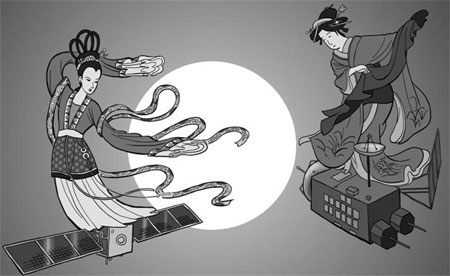China: To the Moon!

A Chinese satellite successfully entered lunar orbit Monday, a month after Japan put its own probe into orbit around the moon, the AP reports:
Chinese space officials said the Chang’e 1 satellite, part of the country’s ambitious space exploration plans, entered lunar orbit after completing a planned braking operation.
China plans to keep the Chang’e 1 – named after a mythical Chinese goddess who flew to the moon – there for one year, about the same length of time as Japan’s probe. China launched its satellite late last month, while Japan put its into space in September.
The timing of the launches raises the prospect of a space rivalry between the two Asian nations, with India possibly joining in if it carries through on a plan to send its own lunar probe into space in April.
We blogged about the Japanese lunar probe when it launched in September. Meanwhile, back at the 73rd annual meeting of the Indian Academy of Sciences, the lunar probe referenced above is indeed planned for April, 2008, with more missions to follow:
Work on Chandrayaan-1, India’s first lunar probe, was progressing, said J.N. Goswami, Director, Physical Research Laboratory, Ahmedabad. The plan was to launch the spacecraft around April 2008.
Planning for the follow-on mission had started, he said. Apart from an orbiter that would circle the moon, Chandrayaan-2 could also have a soft-lander carrying a robotic rover.
A slide projected by Dr. Goswami during his talk indicated that the Chandrayaan-2 mission could take place around 2011-12.
Wikipedia has some good information on Chandrayaan.
So is this the beginning of an Asian space race? Here’s an opinion piece from Japan, translated into English and published in the China Daily, which argues that China is way ahead of the game:
China already has a high level of space technology. It has launched more than 100 Long March rockets since 1970, while Japan’s H2-A rocket has been launched only 13 times…..
[Now], China’s space development has drastically accelerated. Starting with the launch of the orbiter, China’s lunar exploration program comprises a moon landing and deployment of a moon rover with the retrieval of lunar soil and stone samples. China also aims to advance its technologies for manned spacecraft.
Further, it is moving forward with projects to launch a reconnaissance satellite and another one for its own global positioning system.
In addition, China is launching communication satellites for Venezuela, Brazil and Nigeria, and also received an order from France to launch a communication satellite, showing the commercial success of its program.
China has voiced a strong desire to participate in the International Space Station (ISS) program in which Japan is involved and the United States and Russia play pivotal roles.
Some observers say that in the near future China will become one of the world’s leading nations in the field of space development, equivalent to the United States and Russia.
In contrast, Japan’s space program, despite its successful development of the H2-A rocket, lacks specific targets – including what type of satellite it will launch in the future – due to budget woes.